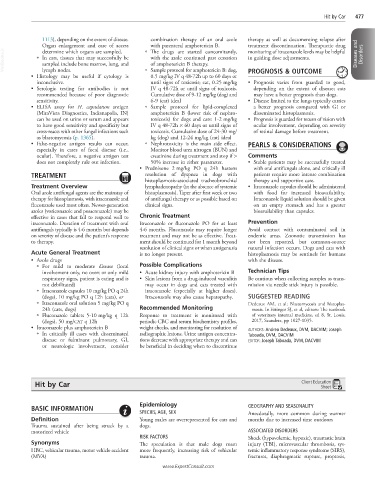Page 970 - Cote clinical veterinary advisor dogs and cats 4th
P. 970
Hit by Car 477
1113), depending on the extent of disease. combination therapy of an oral azole therapy as well as documenting relapse after
with parenteral amphotericin B.
Organ enlargement and ease of access ○ The drugs are started concomitantly, treatment discontinuation. Therapuetic drug
VetBooks.ir ○ In cats, tissues that may successfully be with the azole continued past cessation in guiding dose adjustments. Diseases and Disorders
monitoring of itraconazole levels may be helpful
determine which organs are sampled.
sampled include bone marrow, lung, and
of amphotericin B therapy.
lymph nodes.
• Histology may be useful if cytology is ○ Sample protocol for amphotericin B: dog, PROGNOSIS & OUTCOME
0.5 mg/kg IV q 48-72h up to 60 days or
inconclusive. until signs of toxicosis; cat, 0.25 mg/kg • Prognosis varies from guarded to good,
• Serologic testing for antibodies is not IV q 48-72h or until signs of toxicosis. depending on the extent of disease; cats
recommended because of poor diagnostic Cumulative dose of 9-12 mg/kg (dog) and may have a better prognosis than dogs.
sensitivity. 6-9 (cat) ideal • Disease limited to the lungs typically carries
• ELISA assay for H. capsulatum antigen ○ Sample protocol for lipid-complexed a better prognosis compared with GI or
(MiraVista Diagnostics, Indianapolis, IN) amphotericin B (lower risk of nephro- disseminated histoplasmosis.
can be used on urine or serum and appears toxicosis) for dogs and cats: 1-2 mg/kg • Prognosis is guarded for return of vision with
to have good sensitivity and specificity but IV q 48-72h × 60 days or until signs of ocular involvement, depending on severity
cross-reacts with other fungal infections such toxicosis. Cumulative dose of 24-30 mg/ of retinal damage before treatment.
as blastomycosis (p. 1365). kg (dog) and 12-24 mg/kg (cat) ideal
• False-negative antigen results can occur, ○ Nephrotoxicity is the main side effect. PEARLS & CONSIDERATIONS
especially in cases of focal disease (i.e., Monitor blood urea nitrogen (BUN) and
ocular). Therefore, a negative antigen test creatinine during treatment and stop if > Comments
does not completely rule out infection. 50% increase in either parameter. • Stable patients may be successfully treated
• Prednisone 2 mg/kg PO q 24h hastens with oral antifungals alone, and critically ill
TREATMENT resolution of dyspnea in dogs with patients require more intense combination
histoplasmosis-associated tracheobronchial therapy and supportive care.
Treatment Overview lymphadenopathy (in the absence of systemic • Itraconazole capsules should be administered
Oral azole antifungal agents are the mainstay of histoplasmosis). Taper after first week or two with food for increased bioavailability.
therapy for histoplasmosis, with itraconazole and of antifungal therapy or as possible based on Itraconazole liquid solution should be given
fluconazole used most often. Newer-generation clinical signs. on an empty stomach and has a greater
azoles (voriconazole and posaconazole) may be bioavailability than capsules.
effective in cases that fail to respond well to Chronic Treatment
itraconazole. Duration of treatment with oral Itraconazole or fluconazole PO for at least Prevention
antifungals typically is 4-6 months but depends 4-6 months. Fluconazole may require longer Avoid contact with contaminated soil in
on severity of disease and the patient’s response treatment and may not be as effective. Treat- endemic areas. Zoonotic transmission has
to therapy. ment should be continued for 1 month beyond not been reported, but common-source
resolution of clinical signs or when antigenuria natural infection occurs. Dogs and cats with
Acute General Treatment is no longer present. histoplasmosis may be sentinels for humans
• Azole drugs with the disease.
○ For mild to moderate disease (local Possible Complications
involvement only, no overt or only mild • Acute kidney injury with amphotericin B Technician Tips
respiratory signs, patient is eating and is • Skin lesions from a drug-induced vasculitis Be cautious when collecting samples as trans-
not debilitated) may occur in dogs and cats treated with mission via needle stick injury is possible.
○ Itraconazole capsules 10 mg/kg PO q 24h itraconazole (especially at higher doses).
(dogs), 10 mg/kg PO q 12h (cats), or Itraconazole may also cause hepatopathy. SUGGESTED READING
○ Itraconazole oral solution 5 mg/kg PO q Dedeaux AM, et al: Blastomycosis and histoplas-
24h (cats, dogs) Recommended Monitoring mosis. In Ettinger SJ, et al, editors: The textbook
○ Fluconazole tablets 5-10 mg/kg q 12h Response to treatment is monitored with of veterinary internal medicine, ed 8, St. Louis,
(dogs), 50 mg/CAT q 12h periodic CBC and serum biochemistry profiles, 2017, Saunders, pp 1027-1035.
• Itraconazole plus amphotericin B weight checks, and monitoring for resolution of AUTHORS: Andrea Dedeaux, DVM, DACVIM; Joseph
○ In critically ill cases with disseminated radiographic lesions. Urine antigen concentra- Taboada, DVM, DACVIM
disease or fulminant pulmonary, GI, tions decrease with appropriate therapy and can EDITOR: Joseph Taboada, DVM, DACVIM
or neurologic involvement, consider be beneficial in deciding when to discontinue
Hit by Car Client Education
Sheet
Epidemiology GEOGRAPHY AND SEASONALITY
BASIC INFORMATION
SPECIES, AGE, SEX Anecdotally, more common during warmer
Definition Young males are overrepresented for cats and months due to increased time outdoors
Trauma sustained after being struck by a dogs.
motorized vehicle ASSOCIATED DISORDERS
RISK FACTORS Shock (hypovolemic, hypoxic), traumatic brain
Synonyms The speculation is that male dogs roam injury (TBI), microvascular thrombosis, sys-
HBC, vehicular trauma, motor vehicle accident more frequently, increasing risk of vehicular temic inflammatory response syndrome (SIRS),
(MVA) trauma. fractures, diaphragmatic rupture, proptosis,
www.ExpertConsult.com

